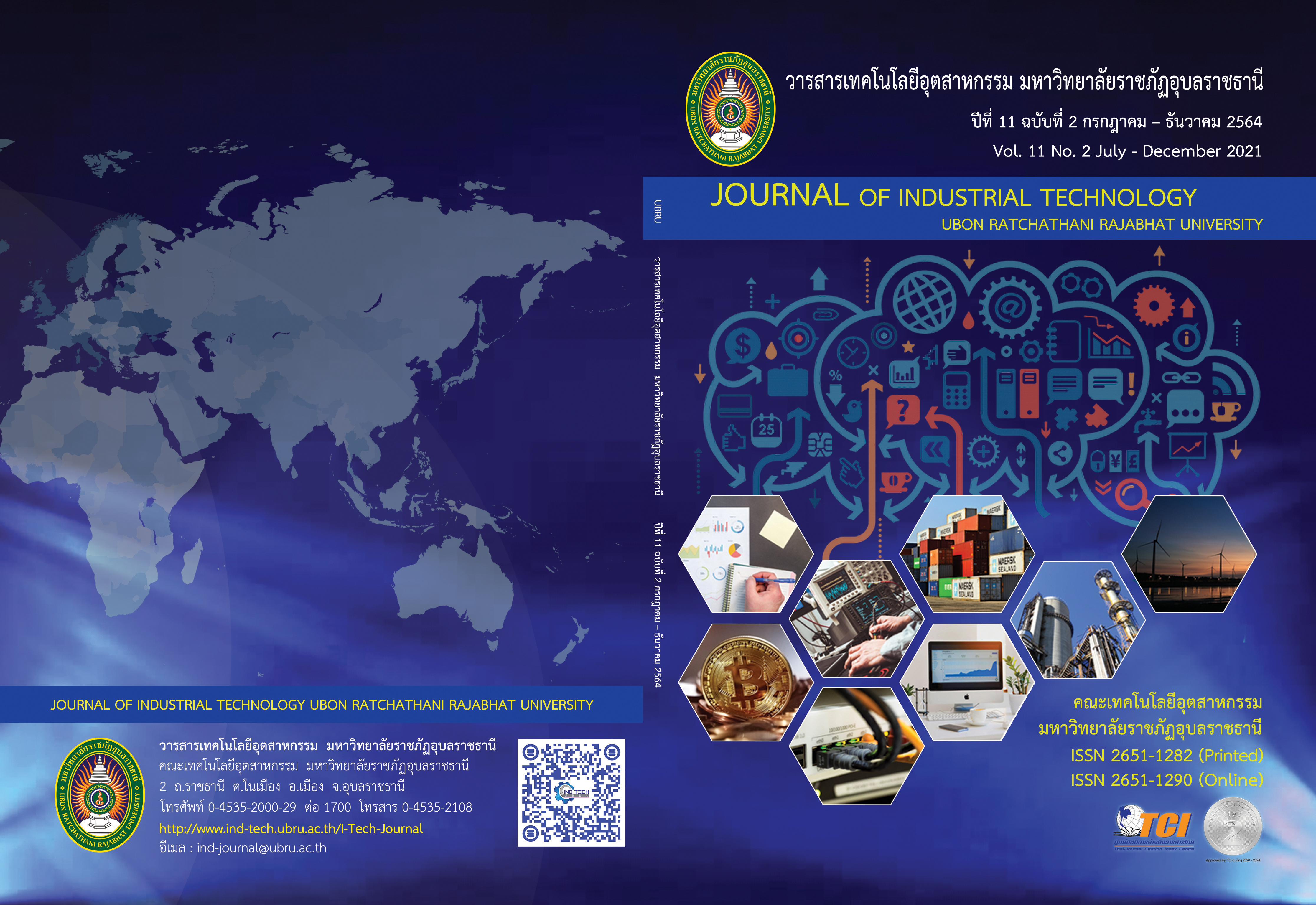ประสิทธิภาพการบำบัดน้ำเสียจากโรงแรมและรีสอร์ทโดยใช้พื้นที่ชุ่มน้ำประดิษฐ์แบบผสม
Main Article Content
บทคัดย่อ
ระบบบำบัดน้ำเสียชีวภาพ ที่ทำการวิจัยนี้เพื่อแก้ไขปัญหาการปล่อยน้ำเสียของโรงแรมและรีสอร์ท ที่มีลักษณะของน้ำเสียจากกิจกรรมของมนุษย์เป็นสำคัญ จากการประกอบอาหาร เศษอาหาร เครื่องปรุง และคราบน้ำมัน จากการทำความสะอาดชำระล้าง ผงซักฟอกและน้ำยาล้างห้องน้ำ เป็นหลัก ดังนั้นการใช้พื้นที่ชุ่มน้ำประดิษฐ์แบบผสมทดลอง สลับใช้พืช 4 ชนิด ผักกูด บัวอเมซอล เตยหอม และบัวบก เพื่อหาประสิทธิภาพในการบำบัดน้ำเสียจากโรงแรมและรีสอร์ทของพืชแต่ละชนิด การทดลองพบว่า น้ำเสียที่ไหลผ่านระบบบำบัดพื้นที่ชุมน้ำประดิษฐ์ผสม โดยพื้นที่ชุมน้ำประดิษฐ์แบบไหลผ่านผิวดิน 1 ถัง ที่อัตราการไหล 0.1221 ลูกบาศก์เมตรต่อวัน และพื้นที่ชุ่มน้ำประดิษฐ์แบบไหลผ่านตัวกลาง 2 ถัง ที่อัตราการไหล 0.1361 ลูกบาศก์เมตรต่อวัน ระยะเวลาผ่านระบบ 9 วัน การทดลองพบว่าพืชที่มีผลบำบัดดีที่สุด คือ ผักกูด โดยมีประสิทธิภาพการบำบัด ค่าบีโอดี ร้อยละ 94.27, ค่าซีโอดี ร้อยละ 96.67, ค่าของแข็งละลายน้ำ ร้อยละ 25.72, ค่าสารแขวนลอย ร้อยละ 95.62, ค่าน้ำมันและไขมัน ร้อยละ 99.60 ค่าทีเคเอ็น ร้อยละ 92.67, และค่าความเป็นกรดและด่าง อยู่ที่ 6.70 และมีคุณภาพผ่านเกณฑ์มาตรฐานน้ำทิ้งของกรมควบคุมมลพิษ กระทรวงทรัพยากรธรรมชาติและสิ่งแวดล้อม
Article Details

อนุญาตภายใต้เงื่อนไข Creative Commons Attribution-NonCommercial-NoDerivatives 4.0 International License.
บทความที่ได้รับการตีพิมพ์ในวารสารฯ ท้ังในรูปแบบของรูปเล่มและอิเล็กทรอนิกส์เป็นลิขสิทธิ์ของวารสารฯ
เอกสารอ้างอิง
Department of Tourism, Ministry of Tourism and Sports. Tourist statistics year 2018 [Internet]. [Access at 2019 August 19]. Retrieved from: https://www.mots.go.th/more_news.php?cid=531. (in Thai)
Jentrakulroj V, Pangkesorn A, Boonpalit A. The Design Guideline for Ecological Friendly Resorts.
Veridian E-Journal, Silpakorn University (Humanities, Social Sciences and arts) 2017; 2641-52. (in Thai)
Pollution Control Department. Guide for management wastewater from buildings, hotels [Internet]. 2016 [Access at 2019 August 20]. Retrieved from: http://slbkb.psu.ac.th/xmlui/ handle/2558/2817?locale-attribute=en. (in Thai)
Panrare, A. Sohsalam, P. Tondee, T. Constructed wetland for sewage treatment and thermal transfer reduction. Energy Procedia. 2015; 567-75.
YE, Fenxia; LI, Ying. Enhancement of nitrogen removal in towery hybrid constructed wetland to treat domestic wastewater for small rural communities. Ecological Engineering, 2009, 35.7: 1043-50.
Ngamzhaluai J, Akamphon K, Jindarojana J. Assessment of Economic Benefits From Improvement of Water Use Efficiency in Sugar Factory: Case Study of Mitr Phu Viang Sugar Mill in Khon Kaen Province. KKU Research Journal (Graduate Studies), 2012, 12.3: 1-7. (in Thai)
Pollution Control Department. Summary of guidelines for design wastewater collection systems and community water quality improvement plants, book 1. Bangkok: The Environmental Engineering Association of Thailand; 2003. (in Thai)
Reed, Sherwood, et al. Water reuse for sludge management and wetland habitat. Water Science and Technology. 1996; 33.10-11: 213-219.
Metcalf, Leonard, Harrison P. Eddy, and Georg Tchobanoglous. Wastewater engineering. New York: McGraw-Hill; 1979.
Yimrattanabovorn J. Combined Constructed Wetlands for Wastewater Treatment in Small Community. School of Environmental Engineering, Institute of Engineering, Suranaree University of Technology. Nakhon Ratchasima: Suranaree University of Technology; 2007. (in Thai)
Thongphrom S. Efficiency of Peat Swamp Forest as Natural Wetland for Wastewater Treatment of Ban Mai Khao Community, Thalang District in Phuket Province. Journal of Food Health and Bioenvironmental Science, 2014, 7.3: 1-16. (in Thai)
Somprasert S, Nilratnisakorn S. Sarnpra P, Podam S. Efficiencies of Constructed Wetland Systems Using Native Plants for Treatment of Strong Acidity Wastewater. Thai Environmental Engineering Journal, 2016, 30.1: 49-57. (in Thai)


